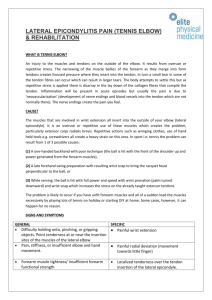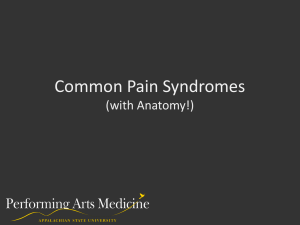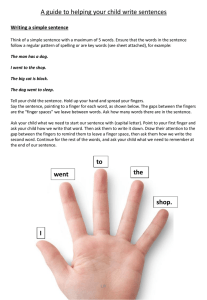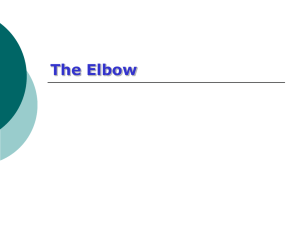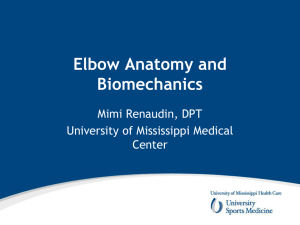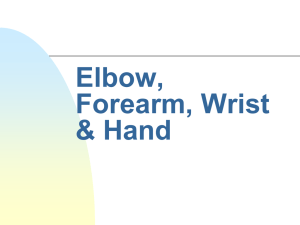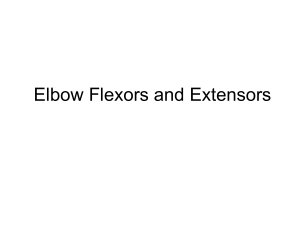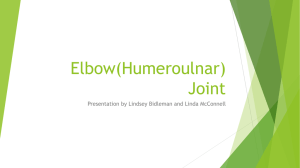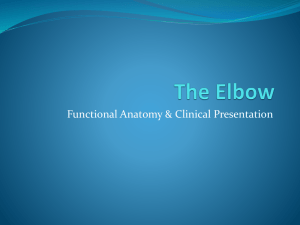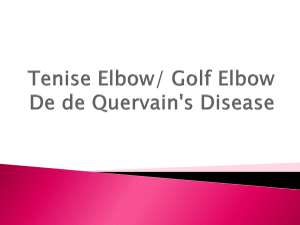The Elbow, Wrist, and Hand
advertisement
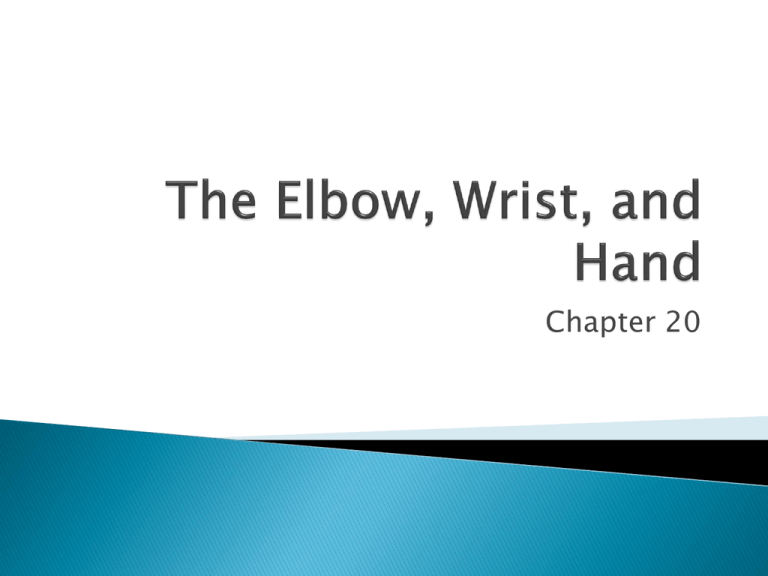
Chapter 20 The Wrist and Hand ◦ Made up of 27 bones 8 carpal bones make up the wrist 5 metacarpals from the structure of the hand 14 phalanges 2 for the thumb 3 for each other 4 fingers 3 bones of the elbow joint ◦ Humerus ◦ Radius ◦ Ulna Many structures surround the elbow ◦ ◦ ◦ ◦ Ligaments Nerves Muscles Bursa sacs Forearm Flexors ◦ Brachialis ◦ Biceps Brachii ◦ Brachioradialis Forearm Extensors ◦ Triceps Brachii ◦ Anconeus Several causes for a variety of athletic injuries ◦ Direct trauma ◦ Indirect trauma ◦ Acute/Chronic stresses These MOIs can result in several injuries ◦ ◦ ◦ ◦ ◦ ◦ Contusions Sprains Strains Dislocations Fractures Nerve involvement Common injury that may involve the muscles of the forearm and subcutaneous bony prominences of the elbow ◦ Usually caused by a direct blow Symptoms Treatment ◦ Bruising ◦ Subsequent bleeding ◦ Stiffness during function or active motion ◦ PRICE Prevents myositis ossificans Inflammation of the olecranon bursitis ◦ Caused by direct blows to the olecranon process ◦ Can be accompanied by infection due to the frequent abrasions that occur over the tip of the elbow Treatment ◦ Depends on whether infection is involved ◦ Uninfected bursitis Ice compresses Rest ◦ Anti-inflammatory meds ◦ Pain meds ◦ Aspiration of the bursa Caused by a direct blow the medial epicondyle of the humerus ◦ Athlete complaints of immediate pain and burning sensation down the ulnar side of the forearm to the ring and little fingers Also known as hitting the “funny bone” Treatment ◦ None is usually necessary Normally occur with a sudden overload to the elbow joint ◦ can acute or chronic Acute Strains Chronic Strains Common areas of acute strains ◦ Sudden excessive overload ◦ Tenderness over the affected area ◦ Pain on function or resisted motion ◦ Result of continued overuse ◦ Overuse syndrome ◦ Chronic degenerative processes ◦ Common flexor tendon Medial epicondyle ◦ Common extensor tendon Lateral epicondyle Usually due to forced hyperextension or valgus/varus forces Symptoms ◦ ◦ ◦ ◦ ◦ Click or pop Sharp pain at injury Tenderness Localized swelling Pain when repeating MOI Usually relieved by bending the elbow Usually caused by repetitive overload of the attached musculotendinous units ◦ Occurs in the region of the medial and lateral epicondyle of the humerus ◦ Called “tennis elbow” if lateral ◦ Called “golfer’s elbow” if medial ◦ If it occurs in younger patients, called “little leaguer elbow” ◦ Can also accompany an injury to the growth plate of the epiphysis Symptoms ◦ ◦ ◦ ◦ Pain when used Possible swelling Local tenderness Pain with resisted wrist motion ◦ ◦ ◦ ◦ ◦ May develop into prolonged degenerative changes Causes chronic epicondylitis Contractures of the elbow Reduced friction Possible rupture of muscle tendon unit Without proper treatment condition may worsen Treatment Preventive measures ◦ RICE ◦ Modifying activities that aggravate conditions ◦ ◦ ◦ ◦ Using proper technique/equipment Limiting stress Adequately warming up stretching Most commonly involves the posterior displacement of the ulna and radius in relationship to the humerus ◦ Often caused by a fall onto an outstretched hand with elbow in extension Symptoms ◦ ◦ ◦ ◦ Obvious deformity Loss of elbow function Considerable pain Initial exam should include evaluation of nerve function of hand and fingers Treatment ◦ Immobilzation ◦ Immediate referral to physician of medical facility ◦ Possible vascular and neurological damage The result of either direct trauma or indirect stresses transmitted through the upper extremity by falling on an outstretched arm ◦ Fractures in younger athletes commonly involve epiphyseal plate fractures Symptoms ◦ ◦ ◦ ◦ ◦ ◦ ◦ Directly related to degree of severity Point tenderness Hemorrhaging Swelling Limited ROM Disability at elbow or hand Increased pain with movement Treatment ◦ Immobilization ◦ Ice ◦ Prompt referral to physician or medical clinic Occurs in the absence of blood flow (ischemia) to the forearm ◦ Can lead to contracture, where joint remains bent and cannot straighten Causes 3 Levels of severity in Volkmann’s Contracture ◦ Increased pressure from swelling or trauma ◦ Fracture ◦ Mild Involves contracture of 2 or 3 fingers No limited loss of sensation ◦ Moderate Involves all fingers being flexed Thumb stuck in palm Wrist may be stuck in flexion Usually loss of sensation in the hand ◦ Severe Involves all muscles in forearm (flexors and extensors) Fingers Severely disabling condition Symptoms ◦ Severe pain when a muscle running through a compartment is passively moved ◦ Forearm may be swollen ◦ Shiny ◦ Painful when squeezed ◦ Pain does not improve with rest, but continues to worsen with time ◦ If condition is not corrected Decreased sensation Weakness Paleness of the skin Repetitive throwing and/or swinging can cause irritation, compression, or entrapment in the cubital tunnel ◦ Called cubital tunnel syndrome Symptoms ◦ Pain along the inner aspect of the elbow ◦ Tenderness of the medial epicondylar groove ◦ Paresthesia (numbness or tingling) of ring and little finger Usually caused by entrapment of the nerve which passes through a tunnel formed by several muscles and tendons ◦ Also called radial tunnel syndrome Symptoms ◦ Pain over lateral aspect of the elbow ◦ Pain over radial head Includes entrapment or compression due to hypertrophy of the pronator teres or repetitive pronation of the forearm ◦ Called pronator teres syndrome Symptoms ◦ Pain radiating down the anterior forearm ◦ Numbness and tingling in the thumb, index, and middle fingers ◦ Resistive pronation may increase the pain Muscles that move the Wrist ◦ 2 Flexor Carpi muscles ◦ 2 Extensor Carpi muscles ◦ 2 Palmaris muscles Muscles that move the Hand ◦ 1 Supinator muscles ◦ 2 Pronator muscles Muscles that move the Thumb ◦ ◦ ◦ ◦ ◦ 2 2 1 2 1 Flexors Extensors adductor abductors opponens ◦ ◦ ◦ ◦ 3 2 3 1 flexors extensors abductors adductor Muscles that move the Fingers Common injuries ◦ ◦ ◦ ◦ ◦ ◦ Fractures Dislocations Contusions Sprains Tendonitis Nerve Impingements Can involve any of the 14 phalange bones. ◦ Most can be treated with a finger splint Boxer’s Fracture ◦ A break of the 5th metacarpal leading to the little finger Baseball (mallet) finger ◦ Painful injury that occurs when a ball or other object strikes the tip of the finger, bending it beyond its normal ROM which tears the finger tendon and damages cartilage Jersey Finger ◦ Caused by tearing the flexor tendon to the fingertip Usually occurs from grabbing a jersey during a tackle. Ring finger is the most often affected Scaphoid fracture ◦ Affects the scaphoid bone ◦ Paplpation of the anatomical snuffbox will cause pain, indicates a fracture may be present Colles Fracture ◦ A break of the radius just above the wrist Treatment for all fractures ◦ RICES (rest, ice, compression, elevation, support) ◦ Evaluation by a physician Fairly common injuries Causes ◦ Ball striking fingertip ◦ Finger getting hooked into equipment Symptoms ◦ Immediate pain ◦ Swelling ◦ Crooked finger Usually can’t be bent or straightened Treatment ◦ Ice ◦ Immobilization ◦ Immediate treatment by physician Usually caused by direct blows or falling onto a hard surface ◦ With nails become contused, pressure may cause a physician to drain blood from beneath the nail Gamekeeper’s thumb ◦ Sprain of the ulnar collateral ligament of the metacarpalphalangeal joint (MPJ) Common in alpine skiiing ◦ Caused by force applied to the medial side of the thumb, forcing the MPJ to stretch, tear, or even rupture The inflammation of the tendons caused by overuse or repetitive stress Symptoms ◦ Ache or pain at the wrist Worsens forceful gripping, rapid wrist movements or moving the wrist or fingers to an extreme position Treatment ◦ The same as other forms of tendonitis ◦ Most common sites in the wrist Base of the thumb near anatomical snuffbox deQuervian’s tenosynovitis Also called Carpal Tunnel syndrome An inflammatory disorder caused by the following ◦ Repetitive stress ◦ Physical injury ◦ Other conditions that cause swelling around the median nerve near the carpal tunnel Symptoms Treatment ◦ Pain ◦ Numbness ◦ Tingling in the wrist, hand, fingers (except little finger) ◦ Tendency to drop things ◦ Loss of sense of heat or cold ◦ Feeling of swelling, even though it is visibly swollen ◦ Symptoms may occur only when the hand is being used or only when at rest ◦ RICE ◦ In severe cases, surgery to decompress the median nerve A small, usually hard lump above a tendon or in a capsule that encloses a joint ◦ Also called a synovial hernia or synovial cyst It is common in handball, racquetball, squash and tennis ◦ Cause of the cyst is unknown An injury to the extensor tendon affecting the proximal interphalangeal joint (PIP) at the middle of the finger or the distal interphalangeal joint at the end of the finger ◦ Caused by a direct blow to a bent finger Symptoms Treatment ◦ Problems flexing and extending the finger ◦ Physician should be contacted immediately ◦ Joints will be painful and tender ◦ Finger misshapen or deformed ◦ The athlete will not be able to straighten it ◦ Must be done promptly ◦ Athlete may not regain normal use of the finger


